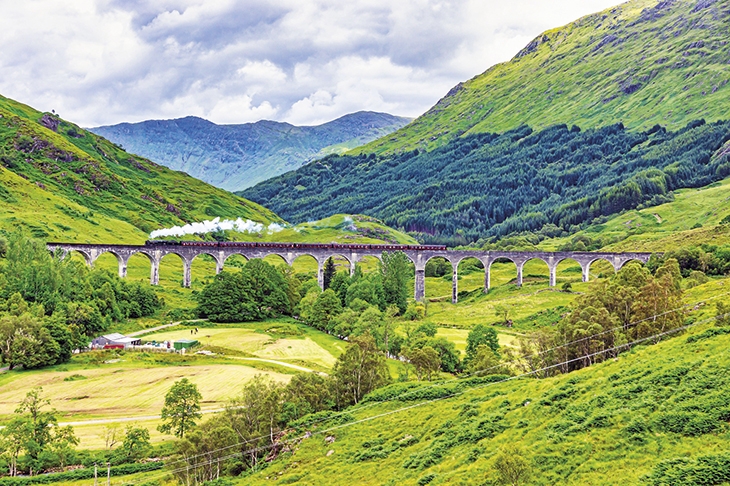So far as most of us are concerned, steam trains vanished in a puff of smoke back in the 1960s, around the time much of the railway network itself disappeared. Other than a few survivors pulling day-trippers along short stretches of track, the received wisdom is that steam is over. Yet the reality is different. True, there is little or no chance of steam trains replacing electric and diesel trains on our modern rail network. But if steam remains history, it is an unusually active and extensive variety of history. Steam has made an impressive comeback under the guise of heritage, to become an enormous national asset. There are an awful lot of those day-trippers. Steam trains (and some rescued diesel locomotives) are now pulling 13 million passengers back in time each year.
Rescuing steam has often meant restoring track as well as rolling stock, because the two are intimately intertwined. Ever since Dr Beeching’s axe descended — and Beeching is the inevitable villain of this volume — doughty enthusiasts have been reversing his cuts. Steam trains are travelling once again along 500 miles of preserved and re-laid track, which runs in parallel to the modern network. At some points the preserved lines even connect up to the modern network, in a surreal mash-up of present and past.
Steam trains in Britain are now pulling 13 million passengers back in time each year
Andrew Martin is a novelist as well as a railway enthusiast, and in what is patently a labour of love he has brought his talents to bear upon this singular resurrection. If his subject matter is a markedly linear mode of transport, he frequently leaves the tracks behind for forays into human hinterlands. Preserved railways are a truly British obsession — there is nothing to match our collection anywhere else in the world. This means in large part his book is a celebration of British eccentricity, since steam trains and lines have so often been saved by maverick individuals.
One key pioneer was Tom Rolt. Back in 1951, he spearheaded the rescue of the Talyllyn Railway, a former freight route for Welsh slate. Rolt was a prolific author as well as a trained engineer, in Martin’s deft summation ‘a sort of Betjeman with oily fingers’. And we might never have heard of the Flying Scotsman were it not for Alan Pegler, who purchased it in 1962 to keep it safe for posterity. In the process, Martin tells us, Pegler bankrupted himself, ‘requiring him to move into a flat above a chip shop opposite St Pancras station, and seek work as an actor impersonating Henry VIII at heritage-themed banquets’. Pegler also helped to save another notable preserved line, the Ffestiniog Railway in Snowdonia.
Martin gives us travelogue as well as history. His subtitle is ‘Journeys Along Britain’s Heritage Railways’ and chuffing around with him is rewarding, not least because preserved lines cross some of Britain’s finest landscapes. In and around diverting minutiae of locomotion, his travels provide pointers for outstanding British trips. Some of his chosen lines are well known. As well as the Welsh duo referred to above they include the Bluebell Railway in Sussex and Kent’s Romney, Hythe and Dymchurch Railway. Martin also climbs aboard lesser known but equally rewarding lines, including the Wensleydale in North Yorkshire and a diminutive urban novelty, the mile-long Middleton in Leeds.
Moreover, the attractions of preserved railways extend beyond steam engines and scenery. They provide travel in comfort, in uplifting contrast to the depressing experience of contemporary trains. Martin singles out the late, unlamented Virgin Trains, reminding us of the comical announcements in their toilets which, after repetition, became maddeningly unfunny.
Preserved railway carriages are often spacious. Seats customarily resemble armchairs and are individually aligned to windows. There is wood panelling to admire. Basins in WCs are not tiny. Ablutions do not feature recorded messages. Martin revels in it all. On occasion he is, perhaps, rather too besotted. On the Welsh Highland Railway, fumes from the engine blow back into his carriage to coat his fellow passengers’ food with coal dust. Martin is undismayed. He records that the ‘relaxing’ smell of the smoke sends him to sleep.
On a more serious whistle note, there may be messages here for today’s transport concerns. It could be that we need to look back, as Martin does, in order to move forward. Safety is one issue. Whether it be steam, diesel or electric, rail travel is far safer than road transport. If the rail network had not been so ruthlessly reduced, thousands of deaths on the roads might have been avoided. And then there are the environmental concerns. Not all the routes cut back in the 1960s were branch lines. Martin cites the Great Central Line, which ran through the Midlands to London. There is ongoing debate as to whether, had it not been pruned, we would now need to build HS2.






Comments